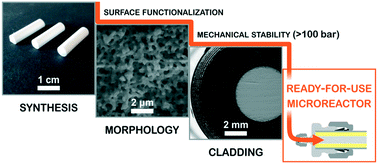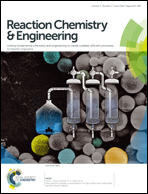Hierarchical silica monoliths with submicron macropores as continuous-flow microreactors for reaction kinetic and mechanistic studies in heterogeneous catalysis†
Abstract
Synthetic attempts towards submicron macropore and skeleton dimensions of hierarchical silica monoliths have so far been plagued by compromised structural homogeneity and/or mechanical stability. We overcome these problems by introducing urea as an agent to control macropore size and skeleton thickness (in addition to mesopore size) as well as a low-cost, straightforward method to achieve a seamless stainless-steel cladding of the monolithic silica rods tolerating pressures of >100 bar. Increasing the urea content of the starting sol comprising a sulfuric acid solution of tetraethoxysilane, poly(ethylene oxide), and urea from 3 to 24 wt% decreases the macropore size from 2.3 to 0.6 μm, the skeleton thickness from 2.0 to 0.4 μm, and increases the mesopore size from 10 to 26 nm. We assume that with increasing urea content of the starting sol, phase separation and gelation are retarded as well as shifted closer together, so that the formed monolithic structures represent a less evolved state of spinodal decomposition, preserving smaller macropores and a thinner skeleton. After cladding, the surface functionalization with aminopropyl groups yields a continuous-flow microreactor (5 mm i.d. × 4 cm length) used for heterogeneous catalysis of the Knoevenagel condensation between benzaldehyde and ethyl cyanoacetate. The catalytic testing and kinetic studies with an on-line coupled reaction–analysis system reveal plug-flow conditions in the microreactor and the elimination of diffusive transport limitations demonstrating the overall success of the preparation. The proposed scheme enables academic laboratories to prepare hierarchical silica monoliths with desirable morphological properties (addressing particularly submicron macropore size and skeleton thickness) and versatile surface functionalization for demanding applications in adsorption, separation, organic synthesis, and catalysis.



 Please wait while we load your content...
Please wait while we load your content...